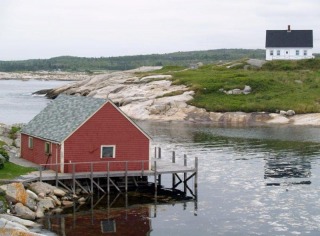
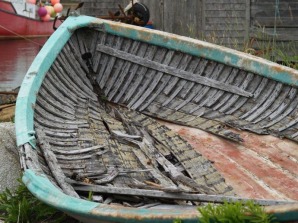
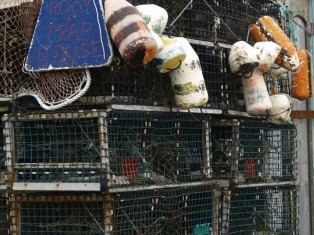
| Dougall Photography |
|
|
Today's Guest Photo Blog is brought to you by Jeff Fidyk, a wonderful photographer with a natural eye for creating images that are visually quite interesting. On a recent trip to Nova Scotia, Jeff created these images below.  I always enjoy taking a different perspective on things, whether it’s a matter of opinion or with respect to photography. Case in point is a recent excursion we made to Peggy’s Cove while visiting Halifax for a few days. Of course the feature attraction at Peggy’s Cove is the iconic lighthouse perched atop a barren landscape of rock that cascades to the Atlantic. However, me being me, I actually took a greater interest in exploring and photographing the area leading up to and adjacent to the famous icon.  Not to say that I didn’t shoot the lighthouse; I did walk away with nine shots of the lighthouse itself from different vantages. My point is exemplified by the 81 photos I took of the various things in the area that caught my interest and in my opinion express more about the area and of our experience there than simply focusing on one simple icon that every other person with a camera will also have added to their collections. These images are of a few of the things that caught my interest.  I am using an Olympus E-500 with a 14-45mm lens. For many of the shots I let the camera auto-select the aperture and shutter speed and I fine-tuned the white balance. I was really pleased with the accuracy achieved with color tones and brightness using this method. I really enjoy taking detail shots as illustrated by the stack of lobster traps, inadvertently decorated with the colourful buoys. The tattered old boat with its detailed ribbing was also intriguing. In the case of the boat, the phrase “one man’s garbage is another man’s art” is likely appropriate. 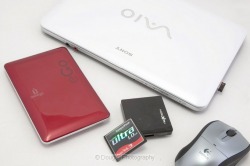 Netbook, external drive and accessories Time was when we went on a long trip like an Alaskan cruise we had to calculate how many pictures per day we would take and then buy and carry a great deal of film with us. Heavy use for me used to be two 36 exposure rolls a day. Those days, thankfully, are long gone. The problem today is we take more pictures and go through memory quite quickly. I can't believe that even with a 32GB card in my Canon 5D MK II and close to 1000 exposures available, I still seem to have to ration my memory cards on a longer trip. If you're are headed on an Alaskan cruise, chances are you are going to be taking a lot of photos - possibly more than will actually fit on your memory cards. Running out of card space while on holidays can be a bit of a hassle, but you have several options available to you before and after the fact: 1. Buy more cards before you go: memory today is cheap. I can walk into my local Costco and pick up a 36G card for about $100. Back in 2001 you couldn't buy 256MB of memory for that kind of money. 2. Buy more cards along the way: many ports have shops that will sell you additional cards at only slightly usurious rates. Still, it would be cheaper to buy them on shore than from the photo shop on your ship! 3. Record only one format: if you are used to recording RAW and JPEG's at the same time, go for the RAW and post process to JPEG later. Depending on your camera, this could let you take 25% more photos on the same memory card. Going only for JPEG's will let you cram more images into the same amount of space as RAW files, but you might not want to forego the flexibility of RAW. 4. Delete some of the images that just don't work: while you always want to bring back all your images and edit them later, sometimes this is the only way to get more memory card space. Be very careful to erase only the images that don't capture the right moment or composition. It is dangerous to judge exposure on the small, bright LCD screen of a camera. 5. Backup onboard: check with the computer lab onboard ship to see if there is a time set aside for passengers to transfer their pictures to DVD. Some labs still only burn CD's which hold next to no data. Even standard DVDs only hold 4.7 GB, meaning my 32GB card would need 7 single sided DVD's to transfer all images. As an alternative to DVD's, if you own a large thumb drive (32GB), you can have the capacity of 7 DVD's in a tiny device, but it still may not be enough backup space for you. 6. Backup onshore: use an onshore Internet Cafe to transfer (or upload) images. In Alaska, Seaport Cyber Cafes are available in most ports. Currently rates are about $6.00/hour. For free Internet access, try the public libraries in any port. Be warned though, these are popular places and you will want you to get there early. 7. Bring your own laptop: I travel with a netbook with a 250GB hard drive and a small, external 500GB hard drive. The netbook is my solution. It's small and easy to carry and lets me backup my images in my cabin at any time for no additional cost. For me, bringing lots of memory and a small netbook to back everything up works well. Think through some of your options ahead of time as your options diminish once your are on your cruise. There is nothing worse than running out of memory just as the whales begin to breach!  Fading Fast Floral is a small community - actually now just a railroad siding - southeast of Saskatoon best known as the birthplace of Mr. Hockey, Gordie Howe. Ten years ago the grain elevator, marked with the now defunct Saskatchewan Wheat Pool emblem, stood on a railroad siding and was actually in use buying grain from local farmers. Since then the railroad line is gone, the elevator has been removed and the Saskatchewan Wheat Pool has morphed into something quite different. For all of these reasons I call this image "fading fast". This was actually one of the first images I shot with my newly acquired Canon D30, my first DSRL back in 2001. The original color image has nowhere the same impact as this converted black and white etching. I don't do much of this artistic filter work, but in this instance I am very pleased how this worked out. I think that any image that you are still happy with after looking at it for ten years can't be that bad!  Paris Mon Amour I have sat in front of the large black and white photograph for years. It hangs on the wall just outside the women's fitting room in a local department store. There are two chairs next to the photo to accommodate husbands and boyfriends caught in that fashion limbo that requires us to wait patiently for our significant other. As I whiled away my time in this limbo, I have come to know this photograph rather well. Shot from inside an apparently empty Paris cafe, the darkness of the interior contrasts with the brightness of the summer day outside. There is only one person visible in the image and they are caught, hanging mid stride in the air, as they run across a wide roadway. While a few cars and one street car can be seen in the photo, it is otherwise a quiet, static photo. I don't know whether it is my innate love of Parisian cafes, the dynamic range captured in this image, the sense of depth, or the feeling of a moment caught in time, but I have always enjoyed looking at this image. I imaged that it may have been shot in the 70's as the pedestrian's pants look like they may be bell bottoms, but there wasn't much else I could derive from the unnamed image in the department store. Fast forward a great many years until today, sitting with my old friend the Parisian cafe image, I decided to photograph it with my iPone and then mail it on to my main email program at home This may sound like I was pirating the image for my own use, but actually, I wanted to run a program called TinEye that I have recently used as a reverse image search tool. You point TinEye at an image on the Internet or on your computer and it will find other examples of the image on the Internet. I use it to determine who is using my stock images as I really have no other way of finding examples of my photos being used on web sites. When I loaded the photo from the department store into TinEye, it quickly showed me a number of other instances of the image appearing on the Internet and I learned that it was called "Le Cafe de Flore tote le matin" or "Cafe de Flore, Early Morning", shot by Jeanloup Sieff in 1975. The search also produced references to a book sold by Amazon called "Paris Mon Amour" with Sieff's image on the font cover. For less than $14.00 this book is a marvellous collection of Parisian images taken by photographers from the late 19th century onward. Sieff, who passed away in September 2000, was a fashion photographer who was well known for his work with such magazines as Harper's Bazaar, Vogue and Glamour. My old friend the department store photo now had a pedigree and just for the heck of it, I decided to see if the Cafe de Flore still existed. I fired up Google Maps and entered the name of the cafe and sure enough, on the ground floor of the Hotel Jardin de Paris, on the corner of Boulevard Saint-Germain and Rue Saint-Benoit, sits the Cafe de Flore still in operation today! Now of course, I had to see if there was a street view from the cafe to try and stand where Jeanloup did when he took the image and indeed I could "stand" on the street just outside the cafe. While some of the businesses have changed, the newspaper kiosk is still across the street from the cafe and the surrounding buildings are still the same. The main difference I think is the amount of traffic on Boulevard Saint-Germain. Today rather than hovering above the street as the pedestrian in the photo did, you would have to fly across if you wanted to avoid the passing traffic! I am amazed how technologies now can come together to help solve these visual mysteries and I am also pleased that now, as I sit beside my old friend, I better understand exactly where this image was taken and by whom.  Dragon Fly and Lily There is not much to say about this shot other than it is great to be able to just walk out into your own backyard and find an image like this. For all the journeys I take half way around the world, some of the most astonishing images I have are taken steps away from my back door! 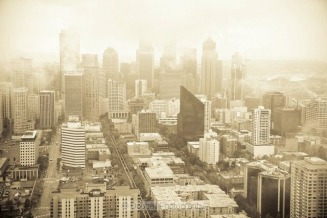 Rain Over Seattle First, don't touch that camera dial that gives you black and white or sepia photos right out the camera. Yes, go ahead and use the VIVID or LANDSCAPE color settings, but please don't go so far as throwing out most of the color in your photographs. Wait until you get back home and do just a little post processing to make your photo into an old time sepia image. This image was taken during a one day port excursion in Seattle. As we pulled into Pier 66 it was dry but cloudy. By the time we made it to the top of the Space Needle it was cloudy almost to the street and very rainy. A wall of fog wrapped around the observation deck with no sense of whether you were one foot or a hundred off the ground. As I stood there the fog lifted for a few moments and I was able to quickly take a some photos down into the city. Looking at the photos once I was warm and dry, I could tell that the rain had wiped out most of the color and some of the sharpness in the images. Rather that try to take the pictures through post processing and make a sunny day out of a downpour, I decided to emphasize the fog and the wet instead. Converting the image to sepia eliminated what little color was in the image and leaves the viewer to concentrate on the forms of the buildings instead. Adding a bit of vignetting draws the viewer's attention to the center of the image and gives the entire picture a vintage feel. I think the image works much better as one that embraces the weather conditions of the day. What didn't work as a color image works much better as a simple toned image. 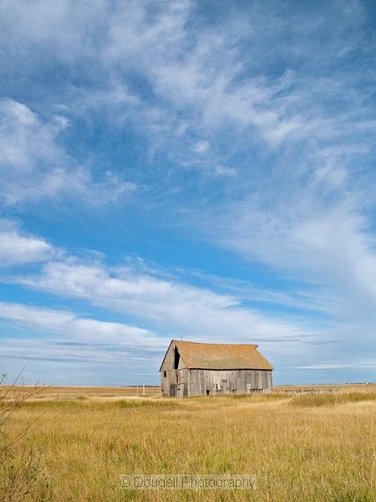 Abanonded Farm Near Saskatoon You have to be born on the prairies to understand that they are not empty and devoid of beauty. There is a majesty to nature that is every bit as inspiring as the mountains or the sea. We have the unending and ever changing blue sky. There is no pollution to wash out or obscure that perfect blue or the ever changing formations of clouds that move above us. I am finding that more and more I am including this dramatic and dynamic picture element in the photos I create. This shot is of an abandoned barn just south of where I live in Saskatoon. I have driven by this structure on a number of occasions, usually in a hurry to go somewhere. This day I had both the time and the camera gear so I stopped and spent an hour or two exploring this wonderful old barn and nearby farmhouse. Good thing I made the stop - the farmhouse has been removed and I am not certain how long the barn will remain standing. Next time you are making a picture, don't forget that the sky might be an important element in your composition! 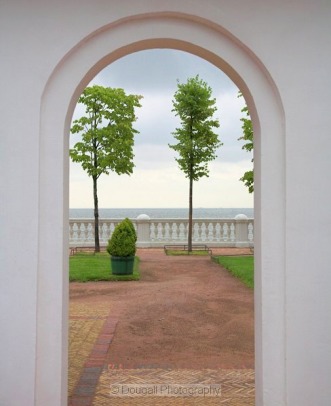 Baltic Sea from Monplaisir Palace Peter the Great built Monplaisir Palace, northeast of the main Peterfhof palace and beside the Baltic Sea, in 1723. He entertained his closest friends in this small summer palace which offers views across the Baltic Sea to St. Petersburg and Kronshtad. The palace is protected from the north winter winds by a wall with a number of archways. These openings nicely frame the view of the Baltic that Peter the Great would have enjoyed almost three hundred years ago. If you are in St. Petersburg and make your way onto the Peterhof territory, save some time to visit the outlying palaces like Monplaisir; you will not be disappointed by the intimate feeling of these smaller buildings. 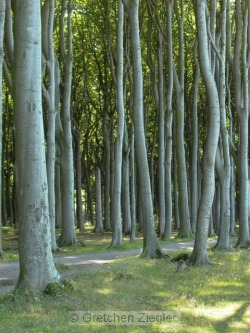 Forest Near Warnemuende, Germany This picture was taken in Warnemuende, Germany. My mom and I did a bike tour and this took us through farmlands, forest, and along the coast. This forest, believe it or not, was along the coast. The beauty of the trees swept me away with their colors and uniformity. I felt like I was in the forest of Hansel and Gretel. This shot was taken with my Leica Digilux 1 (and I can blow it up to 11 x 14 with no pixelation!!). One of my "bucket list" items is to go back here and take more photos at different times of day. I have actually sold this photo in all sizes at local craft shows. My biggest compliment was to have another photo enthusiast buy a copy and cry that she never saw anything so beautiful. As an aside, this forest had an inn nearby that was reasonably priced and also rented bikes with their rooms! We are very pleased that Gretchen Ziegler ([email protected]) was kind enough to write this guest blog and to illustrate it with one of her wonderful photos. Thanks Gretchen! 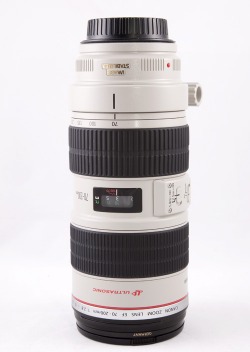 Canon 70-200 f/2.8 IS If I were off on an Alaskan cruise and land tour and took only one lens, it would be a Canon 70-200 f/2.8 IS or, if I shot Nikon, the equally good 70-200 f/2.8 VR. I would also sneak in a 2X extender, giving a range of 70 - 400 (on a full frame camera). I have been on ships, boats, trains, planes and automobiles. I have been on boardwalks, river walks, decks, piers, docks, beaches, and forest trails. In every place the 70-200 performed well. The combination of image stabilizing and fast f/2.8 aperture worked flawlessly in all weather conditions and at all times of the day. I have used the Canon 100-400 f/4.5-5.6 IS, but I hated the push-pull zoom that acted like a pump sucking dust onto the camera sensor each time I used the zoom. While the 100-400 possessed IS, it was a great deal slower than the 70-200. Perhaps surprisingly, the 70-200 is slightly heavier and with the 2X extender factored in, does mean you are carrying a more weight than the 100-400. What about if you use a crop camera? The 70 - 200 will work just fine providing you don't mind the cropped view. Jan, who shoots a 1.6 crop camera, really only uses one lens in Alaska - a Canon 70-300IS DO lens. This lens doesn't get a lot of respect, but its relatively compact size and zoom range has made it an ideal travel companion. With an aperture of 4.5 - 5.6 it's not fast, and 300mm on a crop camera seems closer to 500mm making it a lens Jan has to brace or crank up the ISO in dim conditions. Still, even with these disadvantages, Jan is able to create images that sell quite nicely on iStockPhoto. We are often asked if a lens longer than 400mm should be taken to Alaska and the answer is "no", unless you are doing the Alaskan land tour on your own. If you are on a cruise tour, you are going to find yourself in a vehicle looking out at wildlife as many won't let you out of the bus or van in the presence of wildlife. Inside the cramped quarters of a tour vehicle, there is just not enough swinging room to bring a Canon 500mm to bear on a distant mountain goat. You really need to be on your own where you can setup your large lens away from the madding crowd. So, a general rule of thumb - the more people you are travelling with, the less chance there is of using a long lens. |
Dougall Photography
Blog Archives
June 2018
Blog Categories
All
|